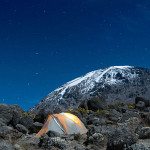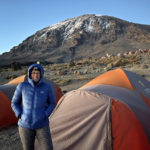
Getting enough sleep on the mountain is an important factor for summit success…but it can be hard. It’s going to be cold on Kili, and buying the wrong bag—or using it incorrectly, and missing out on some of its warmth potential—can be the difference between getting a full night’s rest and getting frustrated by a night full of shivering. Make sure you’re considering all of the following important factors:
The Temperature Rating
This is perhaps the most confusing factor for someone looking to purchase a bag, partially because a 0°F-rated sleeping bag (which we recommend for Kili) is only MOSTLY likely to keep you warm down to 0°F. That’s because the temperature rating is based on an “average sleeper,” a category with very few members.
When you’re deciding between temperature ratings, it’s important to remember that no matter what rating the bag gets, the manufacturers assume it will be that efficient only if you’re wearing a full layer of thermal long underwear, socks, possibly a hat, and are sleeping on a sleeping pad. If you’re not, the temperature rating will be significantly off.
Whether it works as well as it claims it will for you also depends on another hugely variable factor:
How You Sleep and How You Feel
Are you the one who’s always kicking off a blanket in the middle of the night, because you seem to be stoking an internal furnace? Or are you piling on the comforters and still waking up chilly?
Whether you’re a “hot” or a “cold” sleeper is a huge factor in whether a bag’s temperature rating is accurate for you. If you’re not sure, bear in mind that women tend to be colder sleepers than men (and should consider purchasing a bag with one temperature rating colder than they might otherwise buy).
Also, remember that how you feel at the end of the day affects how hot you sleep; “hot sleeping” is your body burning through fuel; if you’re hungry, tired, or dehydrated, your body will have fewer resources to expend towards heating you up (so you’ll want a bag that’s doing more work for you).
The Fill
This is a perennial question from trekkers: “down or synthetic?”
The short answer? Synthetic.
It’s a bit heavier, but it’s generally less expensive. It’s also important to remember that Kilimanjaro isn’t just a cold environment, it’s a wet one. Not only are synthetics better at wicking moisture away from you while you sleep (something that can help you dry clothes or just stay warmer), they work even if they get wet.
Down’s a great insulator…until it gets doused, at which point, all its insulating properties go out the window.
Pro Tip: Both down and synthetic will work better if you shake the bag out vigorously before getting in.
The Shape
Sleeping bags generally come in three shapes: rectangular, mummy-style (which looks like an Egyptian sarcophagus) and tapered, which is somewhere between the other two.
The tighter the fit of the bag, the more of your body heat it will hold in; a mummy bag doesn’t give you much room to move, but it does tend to keep you warmer than a rectangular bag of the same temperature rating.
Some bags also come with hoods; zipping the bag all the way up and cinching this tight around your head will keep in even more warmth.
What’s the takeaway?
Depending on how you sleep, you may want to purchase a bag with an even lower temperature rating than the 0° we recommend for our trekkers. You may also want to purchase a synthetic sleeping bag liner, which can add between 15°F-25°F of additional warmth.
But before you run to the store, consider your lifestyle: do you camp often? Do you regularly camp in cold-weather conditions? As with many products, with sleeping bags you get what you pay for—is it a good investment for you to purchase a high-end, low-temperature-rated bag?
If the answer is “not really,” consider purchasing a liner and renting your bag from us; after all, unless you think a sleeping bag is a good investment, why lose sleep over all these details?






